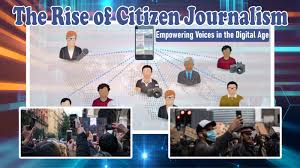In today’s hyper-connected world, news isn’t just delivered by anchors and reporters—it’s being captured and shared by everyday people with smartphones. Welcome to the era of citizen journalism.
Whether it’s a viral video, a tweet, or a live stream, citizen journalism is reshaping how we consume and trust news. But what exactly is it, and how does it impact traditional media?
Let’s dive in.
🧍♂️ What is Citizen Journalism?
Citizen journalism refers to non-professional individuals reporting news using digital tools like smartphones, social media, blogs, and video platforms.
Instead of waiting for mainstream media to cover an event, people are now:
- Sharing real-time footage of breaking news
- Offering first-hand accounts from conflict zones
- Reporting on local issues that may go unnoticed by big networks
It’s journalism of the people, by the people, for the people.
🌍 Examples That Changed the Game
Citizen journalism has played a major role in shaping public opinion and drawing attention to critical events, such as:
- Arab Spring (2010–2012): Protesters used social media to document uprisings in real time.
- Black Lives Matter (2020): Videos from everyday individuals brought police brutality into global focus.
- Ukraine Conflict: Civilians posted raw footage from war zones before news crews arrived.
In many cases, mainstream media picked up these stories only after citizen journalists broke them.
✅ Pros of Citizen Journalism
- Speed & Accessibility
News can be reported instantly, without waiting for professional crews. - Raw, Unfiltered Content
Footage is often more authentic and relatable than polished news packages. - Coverage of Underreported Issues
Local stories, injustices, or grassroots movements get global visibility. - More Diverse Voices
Citizen journalism gives marginalized communities a platform to speak.
⚠️ The Challenges & Risks
While empowering, citizen journalism isn’t without drawbacks:
- Lack of Verification
False or misleading information can go viral quickly. - No Editorial Oversight
Unlike traditional newsrooms, there’s often no fact-checking process. - Legal & Ethical Concerns
Privacy violations, biased reporting, or even incitement can occur. - Misinformation & Deepfakes
Manipulated content can be dangerous when unchecked.
That’s why it’s crucial for viewers to question sources and cross-check facts—even with “viral” news.
📰 How Traditional Media is Adapting
Mainstream outlets are now:
- Partnering with citizen reporters
- Sourcing content from social media (with credit)
- Using AI tools to verify citizen footage
In essence, traditional journalism is evolving—not being replaced—by integrating the public voice.
🤝 The Power of the People
Citizen journalism proves that everyone has the power to hold authorities accountable, highlight social issues, and contribute to the truth. In countries with media restrictions or censorship, it can even be a lifeline to the outside world.
But with that power comes responsibility. To keep journalism credible and ethical, citizen reporters must also uphold basic standards of truth and accuracy.
🧠 Final Thoughts
The rise of citizen journalism is democratizing the flow of information. In a time where trust in media is being questioned, empowering everyday people to tell their stories can restore faith and bring balance to the narrative.
So the next time you see someone reporting live from the street, remember—they might just be the journalist the world needs.































































